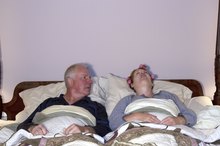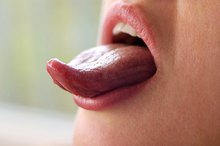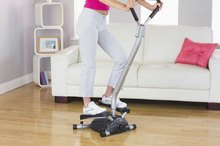4 Exercises to Strengthen the Esophagus Muscle and Improve Swallowing
The esophagus is the medical term for the swallowing tube, the tube that extends from the throat to the stomach. The esophagus is lined with rings of muscles called sphincters at the top and bottom of its length. The strength and function of these sphincters in the top of the tube near the throat allow you to swallow without choking on your food or aspirating or inhaling food from the upper throat into the trachea or windpipe.
If you are experiencing serious medical symptoms, seek emergency treatment immediately.
What Is Dysphagia?
Individuals diagnosed with dysphagia, or difficulty swallowing, may benefit from esophagus-strengthening exercises 1. Symptoms of dysphasia can include frequent heartburn, coughing when eating, drooling, hoarseness and pain with swallowing, according to Mayo Clinic 4.cause:
- Symptoms of dysphasia can include frequent heartburn
- coughing when eating
- drooling
- hoarseness
- pain with swallowing
- according to Mayo Clinic 4
Try Chin Dips
Breathing Exercises for Sleep Apnea
Learn More
Practice chin dips to exercise the esophagus and sphincter at the top of the throat and to facilitate swallowing. For example, when drinking or eating small amounts of fluid or food, dip the chin slightly toward the chest while swallowing. This facilitates positioning of the epiglottis, and narrows the entrance to the throat by the trachea or windpipe.
This is also an effective remedy for individuals who experience difficulty swallowing pills and reduces the chance of choking and regurgitation. You can practice this positioning and swallowing exercise several times throughout the day.
- Practice chin dips to exercise the esophagus and sphincter at the top of the throat and to facilitate swallowing.
Suck and Swallow
This exercise strengthens the muscles of the tongue and forces you to concentrate on the muscles and process of swallowing, as well as pulling more saliva to the back portion of your mouth while you are eating.
Practice by gently pressing the tongue to the back of the front teeth. Pull the cheeks in slightly, as if you're trying to suck air from the tip of your tongue to the back of the mouth. You'll feel a distinct pull along the cheeks, the side of the tongue and the upper part of the throat. Then swallow. Repeat this exercise several times a day.
- This exercise strengthens the muscles of the tongue and forces you to concentrate on the muscles and process of swallowing, as well as pulling more saliva to the back portion of your mouth while you are eating.
Practice Airway Exercises
Exercises to Completely Stop Snoring
Learn More
Strengthen the throat muscles that facilitate swallowing by holding your breath and grasping the side or arms of a chair and pulling upward or pushing downward at the same time. Hold the contraction and your breath for a few seconds and then release. Focus on your throat and, if necessary, lift one hand to feel the throat muscles contracting. This may help you focus on isolating and controlling the proper throat muscles for swallowing.
- Strengthen the throat muscles that facilitate swallowing by holding your breath and grasping the side or arms of a chair and pulling upward or pushing downward at the same time.
- Focus on your throat and, if necessary, lift one hand to feel the throat muscles contracting.
Swallowing Exercise with Held Breath
You can practice swallowing exercises while holding your breath in order to strengthen your throat and sphincter muscles and help prevent choking while drinking and eating 1. For example, place a small amount of fluid in your mouth and keep it there while holding your breath. Concentrate for a moment or two and then swallow, continuing to hold your breath while you swallow. Immediately after swallowing the fluid, cough lightly.
Read more: Diets for Patients With Dysphagia
- You can practice swallowing exercises while holding your breath in order to strengthen your throat and sphincter muscles and help prevent choking while drinking and eating 1.
See a Doctor
Consult your doctor or a speech pathologist if you frequently have difficulty swallowing. These symptoms can be caused by underlying medical conditions that require additional intervention, such as a stroke.
Related Articles
References
- University Health Network: Swallowing Exercises
- National Foundation of Swallowing Disorders: Swallowing Exercises
- Huntsman Cancer Institute: Speech and Swallowing Exercises
- Mayo Clinic: Dysphagia
- Buchholz DW. Dysphagia associated with neurological disorders. Acta Otorhinolaryngol Belg. 1994;48(2):143-55
- Winstein CJ, Stein J, et al. American Heart Association Stroke Council, Council on Cardiovascular and Stroke Nursing, Council on Clinical Cardiology, and Council on Quality of Care and Outcomes Research. Guidelines for Adult Stroke Rehabilitation and Recovery: A Guideline for Healthcare Professionals From the American Heart Association/American Stroke Association. Stroke. 2016 Jun;47(6):e98-e169. doi: 10.1161/STR.0000000000000098.
- Vose A, Nonnenmacher J, Singer ML, González-Fernández M. Dysphagia Management in Acute and Sub-acute Stroke. Curr Phys Med Rehabil Rep. 2014;2(4):197–206. doi:10.1007/s40141-014-0061-2
- Hegland KW, Davenport PW, Brandimore AE, Singletary FF, Troche MS. Rehabilitation of Swallowing and Cough Functions Following Stroke: An Expiratory Muscle Strength Training Trial. Arch Phys Med Rehabil. 2016 Aug;97(8):1345-51.
- Lembo AJ. (2017). Oropharyngeal Dysphagia. Talley NJ, ed. UpToDate. Waltham, MA: UpToDate Inc.
- Rofes L, Arreola V, Mukherjee R, Swanson J, Clavé P. The Effects of a Xanthan Gum-Based Thickener on the Swallowing Function of Patients With Dysphagia. Aliment Pharmacol Ther. 2014 May;39(10):1169-79.
Writer Bio
Denise Stern is an experienced freelance writer and editor. She has written professionally for more than seven years. Stern regularly provides content for health-related and elder-care websites and has an associate and specialized business degree in health information management and technology.









